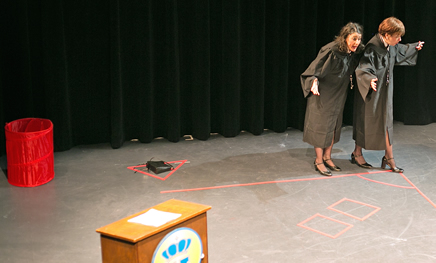From Wednesday through Sunday, art lovers from all walks of life gathered in various venues throughout Wilmington to indulge in films, music, and dance. But perhaps more than any of these, Cucalorus offered something even more valuable: community.
At the opening screening Wednesday night, the festival’s chief instigating officer, Dan Brawley, told the small crowd packed into the Jengo’s Playhouse auditorium, “We’re going to get to know each other over the next four days.” His promise turned out to be prophetic. Over the course of the festival, I watched friendships emerge among attendees who would recognize each other from other screenings throughout the weekend. They built bonds by sharing their opinions, discussing the films, and getting to know one another. While the festival proudly donned the slogan “Circus of the Weird” for their 27th season, I was continuously astonished by the welcoming atmosphere and the diverse crowds that occupied the theater’s seats.
Perhaps more than the people in the audience, the diversity of material onscreen sets Cucalorus apart from other film festivals. In a single day, I saw a collection of short films made for children (Buttercup Shorts: Youth Finding Their Way, dir. various); a soapy morality tale about life as a Black teenager in Boston (Memoirs of a Black Girl, dir. Thato Rantao Mwosa); a gross-out philosophical deep-dive into a man’s struggle with tinnitus, and his subsequent decent into madness (Masking Threshold, dir. Johannes Grenzfurthner); and a slow-burn, punk-metal horror film about a young woman who learns about her genealogical connections to magic and witchcraft (Hellbender, dir. The Adams Family).
Talk about crazy variety! There is quite literally something for everyone at Cucalorus!
All of the films screened at Cucalorus are independent productions, which means that their budgets are significantly lower than the films you might find playing at your local movie-house. North Carolina is exceptionally lucky to have Cucalorus bring in these undervalued films and give them a serious exhibition.
This year, Cucalorus commissioned a film to be made and screened especially for the festival. The commissioned film was created by the radical editing collective Racer Trash, known for taking Hollywood classics and turning them into something unrecognizable. They’ve proudly “blasphemed” such films as Jumanji, Speed Racer, and over 30 others. The group of editors made quite the splash at the Toronto Film Festival and have gained a remarkably large following the short year-and-a-half since they first organized. Aaron Hillis, curator of the “Convulsions” program introduced the film (Convulsions is the late-night, adult-only series that highlights the horrific, the sexy, and the bizarre). Hillis joked that with this commissioned film, Racer Trash was going to “attack and dethrone cinema.” The audience clapped and cheered, eager to participate in “defaming” the art they love so much.
The commissioned piece, Bus to Lumberton, took David Lynch‘s art-house classic Blue Velvet (1986) and transformed it into a wildly trippy and divisive gem; a significant portion of the audience left the auditorium only minutes into the film. Off to the side of the main screen (where the film played), there was a secondary screen that broadcasted a live-stream chat. The audience at Thalian Hall was invited to participate in the chat during the movie – it was the first time I’ve heard a theater encourage viewers to use their phones. The film was simultaneously live-streamed on the popular app Twitch, so there was an additional online audience who could chime into the chat from their remote locations. Those who stuck around, physically and virtually, were mesmerized and swept away by what they saw!
After the film, there was a Q&A with members of Racer Trash, which was equally “sacrilegious” (by any other festival’s standards). Rather than coming to the stage, as is the common practice, Racer Trash fielded questions from their seats in the third-tier balcony of the theater. The whole evening reminded the audience that movies are supposed to be fun and that we ought not to take them too seriously. And that sentiment sums up Cucalorus pretty darn well: this festival is a whole lot of fun.
One last note on what makes Cucalorus special: All weekend, there was a blending of different art forms, which created a powerful and interactive experience. One of the more memorable moments of the festival was the documentary Negra (dir. Medhin Tewolde Serrano) about what it means to be Black in Latin America. Before the film, Destinee Stewart performed an amazingly mighty dance in front of the screen, while an impactful speech by Latin choreographer and activist Victoria Santa Cruz played behind her. Stewart moved, shrunk, jumped, and yelled as Santa Cruz sang from the silver screen. The song closed and Stewart bowed low. She bellowed, “I present… Negra.” Now that’s how you introduce a movie.
Cucalorus doesn’t just cater to film lovers, it also offers a wide array of artistic expressions. Each night, the festival hosted live music concerts, and on Sunday, they hosted a unique event called “Dance-a-lorus,” which included live choreography incorporated with film and other moving image media. The event began with a piece called “Vageuar Purus,” choreographed by Nancy Podrasky Carson, in which a camera on stage captured the dancers’ movements and simultaneously converted them into animation, projecting them on the screen behind. It was a beautiful display of grace and technology. The final piece of the night hit quite close to home. In conjunction with Wilmington’s own Cameron Art Museum, the Sue Meier-choreographed work “And Still, She Persists,” took the audience on a journey through women’s rights movements. From the Suffragettes to Michelle Obama and Ruth Bader Ginsberg, the struggles and triumphs of women in the modern world came vividly to life through the dancers and the images behind them.
For any art lover, Cucalorus is a must. There is truly something for everybody, and they make it accessible. I had the privilege of holding a press pass, which granted me access to all the films, but I had several friends join me for individual screenings. They could purchase individual tickets for no more than it would cost to go see the newest release in theaters!
For four days, the possibilities of art seemed infinite. Each film and event was curated and presented with care and precision. Already, I can’t wait to see what next year has to offer – and if you consider yourself and art lover in any capacity, you shouldn’t miss it either!












